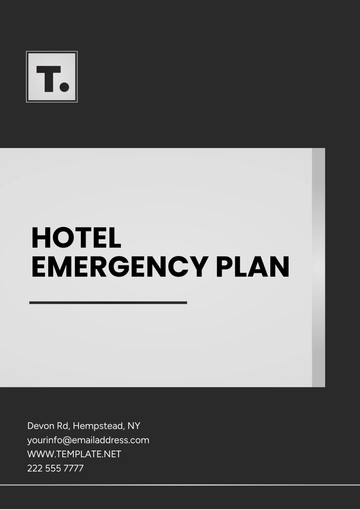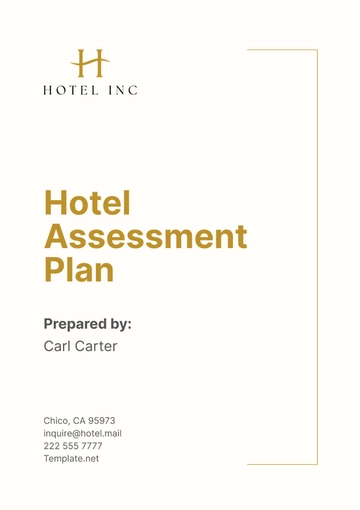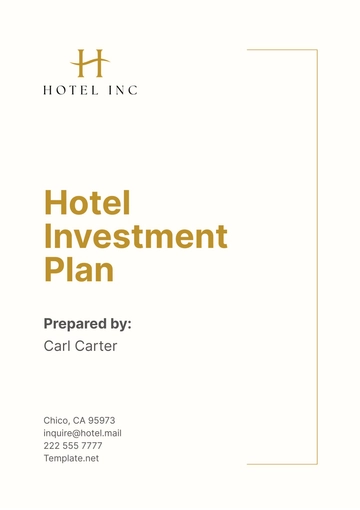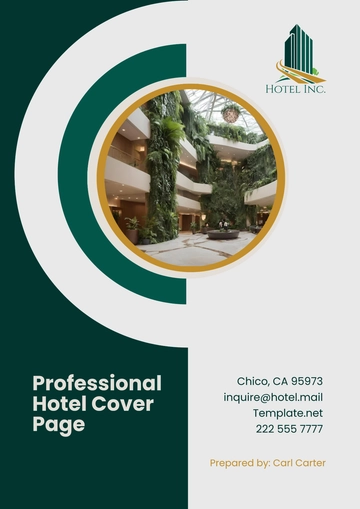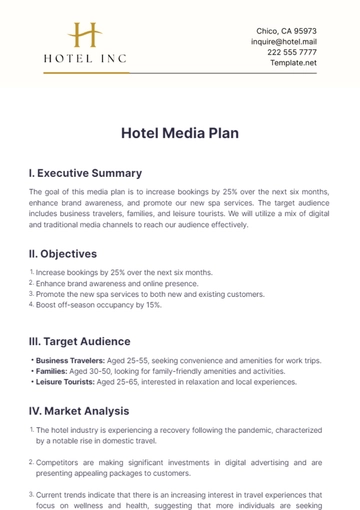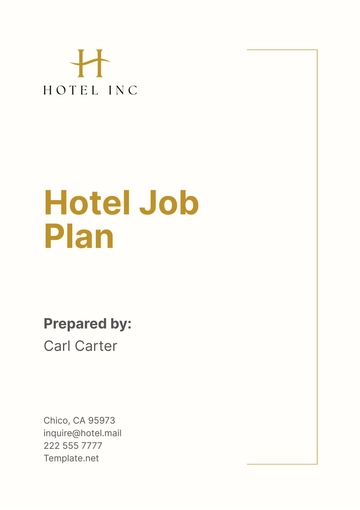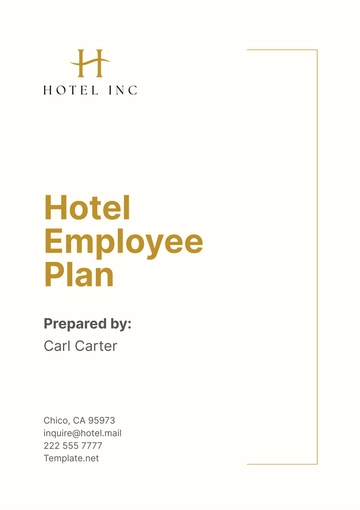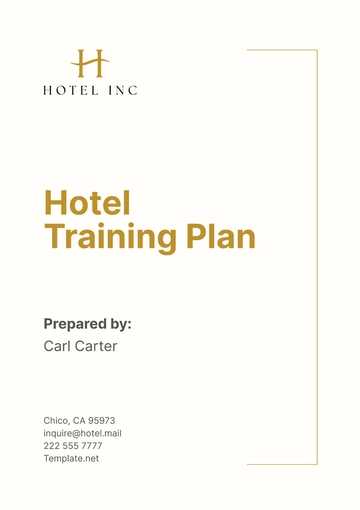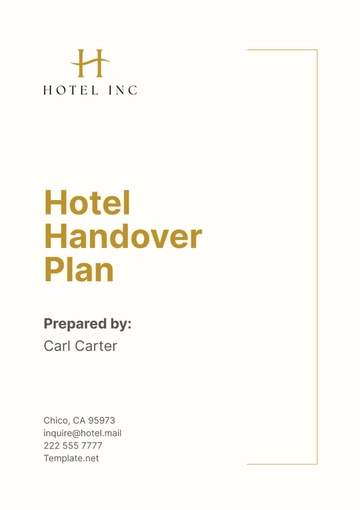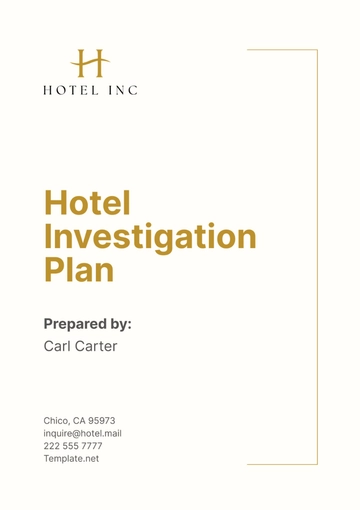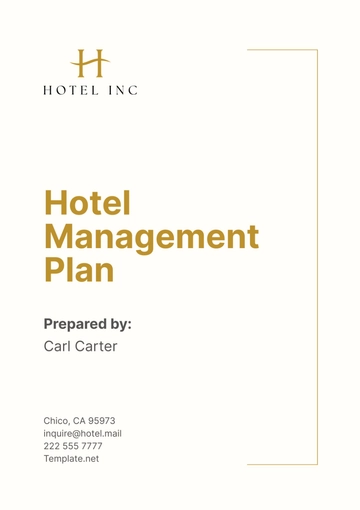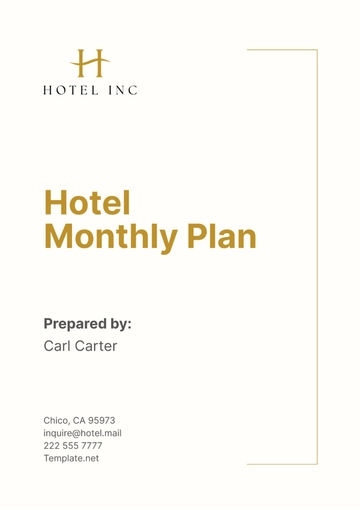Free Hotel Procurement Plan

I. Executive Summary
The Procurement Plan for [Your Company Name] outlines the strategic approach for sourcing and acquiring essential goods and services required to operate our hotel smoothly and efficiently in the year 2058. This plan aims to ensure cost-effectiveness, maintain high-quality standards, and support our overall business objectives.
In 2058, [Your Company Name] is projected to allocate $5,000,000 towards procurement activities, covering areas such as food and beverage supplies, housekeeping materials, maintenance equipment, and technology upgrades. This budget reflects a 10% increase compared to the previous year, aimed at enhancing guest satisfaction and operational efficiency.
Our procurement strategy is designed to build strong relationships with suppliers, negotiate favorable terms, and implement sustainable practices. The ultimate goal is to provide exceptional service to our guests while optimizing costs and ensuring a steady supply of necessary items.
II. Procurement Objectives
A. Cost Optimization
Negotiation Strategies: Employ advanced negotiation techniques to secure the best prices and terms from suppliers. This includes bulk purchasing and long-term contracts, which can significantly reduce costs.
Supplier Competition: Encourage competitive bidding among suppliers to ensure we receive the best value for our expenditures. A competitive environment drives suppliers to offer their best prices and services.
Cost Tracking: Implement robust cost-tracking systems to monitor spending and identify areas for potential savings. Detailed tracking helps in making informed financial decisions.
B. Quality Assurance
Supplier Evaluation: Conduct thorough evaluations of potential suppliers based on quality, reliability, and past performance. This ensures we partner with suppliers who meet our high standards.
Quality Standards: Establish strict quality standards for all procured items, ensuring they meet our hotel's requirements and guest expectations. Maintaining high standards is crucial for guest satisfaction.
Regular Audits: Perform regular audits of supplier facilities and products to maintain high-quality standards consistently. Audits help in identifying and addressing any quality issues promptly.
C. Sustainable Procurement
Eco-Friendly Products: Prioritize the purchase of eco-friendly and sustainable products to reduce our environmental impact. This commitment to sustainability is integral to our brand values.
Green Certifications: Seek suppliers with recognized green certifications and sustainable practices. Partnering with certified suppliers ensures adherence to environmental standards.
Waste Reduction: Implement procurement practices that minimize waste, such as reusable or recyclable packaging. Reducing waste helps in lowering our environmental footprint.
III. Supplier Management
A. Supplier Selection
Criteria Development: Develop comprehensive criteria for selecting suppliers, including cost, quality, reliability, and sustainability. This structured approach ensures we choose the best suppliers.
RFP Process: Utilize a formal Request for Proposal (RFP) process to solicit bids from potential suppliers and select the most suitable ones. The RFP process helps in obtaining competitive pricing and quality.
Supplier Diversity: Promote diversity by considering suppliers of various sizes and backgrounds, including minority-owned and local businesses. Supporting diverse suppliers aligns with our corporate social responsibility goals.
B. Supplier Relationship Management
Partnership Building: Foster strong, long-term relationships with key suppliers to ensure reliability and mutual benefit. Building partnerships enhances trust and collaboration.
Performance Metrics: Establish performance metrics to evaluate and monitor supplier performance regularly. Metrics such as delivery times and product quality are essential for performance tracking.
Conflict Resolution: Develop procedures for resolving conflicts and addressing issues promptly and effectively. A structured conflict resolution process minimizes disruptions.
C. Supplier Evaluation and Audits
Initial Assessments: Conduct initial assessments to ensure suppliers meet our standards before entering into agreements. Preliminary checks help mitigate risks.
Ongoing Audits: Perform ongoing audits to verify continued compliance with our quality and performance standards. Regular audits maintain the integrity of our supply chain.
Feedback Mechanisms: Implement feedback mechanisms to allow suppliers to improve and align with our expectations. Constructive feedback fosters continuous improvement.
IV. Procurement Processes
A. Purchase Requisition and Order Management
Requisition System: Implement a streamlined requisition system to manage internal requests for goods and services efficiently. This system ensures timely and accurate processing.
Order Processing: Standardize order processing procedures to ensure accuracy and timeliness in placing orders. Standardization reduces errors and improves efficiency.
Approval Workflow: Establish an approval workflow to ensure all purchases are authorized and within budget. This control mechanism prevents unauthorized spending.
B. Inventory Management
Stock Levels: Maintain optimal stock levels to prevent shortages and overstock situations. Proper stock management ensures availability without excess.
Inventory Tracking: Utilize advanced inventory tracking systems to monitor stock levels in real-time. Real-time tracking enhances visibility and control.
Periodic Reviews: Conduct periodic reviews of inventory to identify and address any discrepancies. Regular reviews ensure inventory accuracy.
C. Technology Integration
Procurement Software: Invest in procurement software to automate and streamline procurement processes. Automation increases efficiency and accuracy.
Data Analytics: Leverage data analytics to gain insights into spending patterns and identify opportunities for improvement. Analytics support informed decision-making.
Supply Chain Visibility: Enhance supply chain visibility through technology to ensure transparency and efficiency. Improved visibility reduces risks and enhances coordination.
V. Budget and Financial Management
A. Budget Allocation
The following chart and table outline the budget allocation for key procurement categories in 2058:
Category | Budget |
|---|---|
Food and Beverage | $1,500,000 |
Housekeeping Supplies | $1,200,000 |
Maintenance Equipment | $1,000,000 |
Technology Upgrades | $800,000 |
Miscellaneous | $500,000 |
Total | $5,000,000 |
Food and Beverage: Our food and beverage budget ensures we can offer a diverse and high-quality menu to our guests. This allocation covers the cost of ingredients, beverages, and kitchen supplies. By investing in premium products, we aim to enhance the dining experience and cater to a wide range of tastes and dietary needs.
Housekeeping Supplies: Housekeeping supplies are critical for maintaining cleanliness and comfort in guest rooms and common areas. This budget covers items such as cleaning agents, linens, toiletries, and other essentials. Ensuring a steady supply of these materials helps us maintain high standards of hygiene and guest satisfaction.
Maintenance Equipment: Investing in maintenance equipment is essential for the upkeep of our hotel's infrastructure and facilities. This budget allocation covers tools, repair materials, and other equipment needed to address maintenance issues promptly. Effective maintenance practices help prolong the lifespan of our assets and enhance overall operational efficiency.
Technology Upgrades: Technology upgrades are crucial for staying competitive and enhancing operational efficiency. This budget supports the acquisition of advanced systems, software, and equipment. Upgrading our technology infrastructure ensures we can provide modern amenities and improve the guest experience.
Miscellaneous: The miscellaneous category covers unforeseen expenses and minor procurement needs that arise throughout the year. This allocation provides flexibility to address unexpected requirements without disrupting our primary budget categories.
Total: The total budget allocation of $5,000,000 reflects our strategic investment in essential areas to maintain and improve hotel operations. Each category is carefully planned to ensure we meet our quality and service standards while managing costs effectively.
A well-balanced budget across these categories ensures that [Your Company Name] can continue to deliver exceptional guest experiences and maintain operational efficiency. Strategic investment in food and beverage, housekeeping, maintenance, and technology upgrades is critical for our success. The flexibility provided by the miscellaneous budget allows us to adapt to unforeseen needs, ensuring smooth operations throughout the year.
B. Financial Reporting
Regular Reporting: Generate regular financial reports to monitor procurement spending and ensure alignment with the budget. Consistent reporting enables timely adjustments.
Variance Analysis: Conduct variance analysis to identify deviations from the budget and implement corrective actions. Understanding variances helps in maintaining financial control.
Cost Savings Initiatives: Develop and implement cost-saving initiatives based on financial data insights. Proactive measures lead to significant cost reductions.
VI. Risk Management
A. Identifying Procurement Risks
Risk Assessment: Conduct comprehensive risk assessments to identify potential procurement risks, such as supply chain disruptions and price volatility. Early identification allows for proactive management.
Risk Mitigation Plans: Develop and implement risk mitigation plans to address identified risks proactively. Effective plans reduce the impact of potential issues.
Contingency Plans: Establish contingency plans to ensure business continuity in case of unexpected disruptions. Preparedness ensures operational resilience.
B. Supplier Risk Management
Supplier Risk Evaluation: Evaluate suppliers based on their risk profiles, including financial stability and operational reliability. Comprehensive evaluation minimizes supply chain risks.
Diversification Strategies: Implement diversification strategies to avoid over-reliance on a single supplier. Diversification enhances supply chain resilience.
Contractual Protections: Incorporate contractual protections, such as penalty clauses and performance guarantees, to mitigate supplier-related risks. Strong contracts ensure accountability.
VII. Sustainability Initiatives
A. Sustainable Procurement Practices
Green Procurement Policy: Develop and implement a green procurement policy to prioritize environmentally friendly products and services. This policy demonstrates our commitment to sustainability.
Sustainable Suppliers: Partner with suppliers who adhere to sustainable practices and have green certifications. Sustainable partnerships enhance our environmental efforts.
Eco-Friendly Packaging: Advocate for eco-friendly packaging solutions to reduce waste and environmental impact. Innovative packaging reduces our carbon footprint.
B. Waste Reduction Strategies
Waste Audits: Conduct waste audits to identify opportunities for waste reduction and recycling. Audits provide insights into waste management improvements.
Reusable Items: Promote the use of reusable items within the hotel to minimize single-use products. Reusability reduces waste and supports sustainability goals.
Supplier Collaboration: Collaborate with suppliers to develop packaging solutions that reduce waste and environmental impact. Supplier partnerships enhance our waste reduction efforts.
VIII. Performance Monitoring and Improvement
A. Key Performance Indicators (KPIs)
The following table outlines the key performance indicators (KPIs) and benchmarks used to monitor procurement performance:
KPI | Benchmark |
|---|---|
Procurement Cost Savings | 10% annual savings |
On-Time Delivery Rate | 95% or higher |
Supplier Compliance Rate | 98% or higher |
Inventory Turnover Rate | 8 times per year |
Purchase Order Accuracy | 99% or higher |
Procurement Cost Savings: Achieving a 10% annual savings in procurement costs indicates our ability to negotiate effectively and manage expenses. This KPI helps ensure financial efficiency and resource optimization.
On-Time Delivery Rate: Maintaining an on-time delivery rate of 95% or higher ensures that our suppliers meet deadlines and support our operational needs. Timely deliveries are crucial for uninterrupted hotel operations.
Supplier Compliance Rate: A supplier compliance rate of 98% or higher reflects adherence to our quality and performance standards. High compliance rates indicate strong supplier relationships and reliable service.
Inventory Turnover Rate: An inventory turnover rate of 8 times per year demonstrates efficient inventory management. This KPI ensures that we maintain optimal stock levels without overstocking or shortages.
Purchase Order Accuracy: A purchase order accuracy rate of 99% or higher signifies precision in our procurement processes. Accurate purchase orders minimize errors and enhance efficiency.
Monitoring these KPIs helps us track our performance and make informed decisions to improve our procurement practices. Consistently meeting or exceeding these benchmarks demonstrates our commitment to operational excellence and continuous improvement.
B. Continuous Improvement
Feedback Mechanisms: Establish feedback mechanisms to gather input from stakeholders and identify areas for improvement. Constructive feedback drives innovation and process enhancement.
Training Programs: Implement training programs to enhance the skills and knowledge of procurement staff. Well-trained staff contribute to efficient and effective procurement processes.
Innovation and Technology: Embrace innovation and new technologies to continuously improve procurement practices and outcomes. Leveraging technology ensures we stay competitive and efficient.
IX. Conclusion and Next Steps
A. Conclusion
The Procurement Plan for [Your Company Name] in 2058 is designed to ensure the efficient acquisition of high-quality goods and services while optimizing costs and supporting sustainability. By implementing this plan, we aim to enhance guest satisfaction, maintain operational excellence, and contribute to our overall business success.
The comprehensive approach outlined in this plan addresses key areas such as cost optimization, quality assurance, supplier management, and sustainability. By adhering to these strategies, [Your Company Name] is well-positioned to achieve its procurement objectives and maintain a competitive edge in the hospitality industry.
B. Next Steps
To ensure the successful implementation of the procurement plan, the following next steps will be taken:
Implementation of Strategies: Begin the detailed implementation of the outlined procurement strategies, ensuring all departments are aligned and informed. Clear communication and coordination are essential for effective execution.
Supplier Engagement: Initiate engagement with selected suppliers to establish contracts and begin the procurement process. Strong supplier relationships are crucial for reliable supply chains.
Monitoring and Reporting: Set up regular monitoring and reporting systems to track progress against the KPIs and benchmarks. Continuous monitoring allows for timely adjustments and improvements.
Training and Development: Launch training programs for procurement staff to enhance their skills and knowledge. Investing in staff development ensures they are equipped to execute the procurement plan effectively.
Sustainability Initiatives: Implement the sustainability initiatives outlined in the plan, focusing on eco-friendly procurement practices and waste reduction. Commitment to sustainability aligns with our corporate values and enhances our brand reputation.
Feedback Collection: Establish feedback mechanisms to gather input from internal stakeholders and suppliers. Constructive feedback helps identify areas for improvement and fosters a culture of continuous improvement.
Financial Review: Conduct regular financial reviews to ensure spending aligns with the allocated budget and identify opportunities for cost savings. Financial oversight is critical for maintaining budgetary control.
By following these next steps, [Your Company Name] will ensure the successful execution of the procurement plan, driving efficiency, sustainability, and overall business success. Continuous improvement and adaptation to changing market conditions will be key to maintaining our competitive advantage.
- 100% Customizable, free editor
- Access 1 Million+ Templates, photo’s & graphics
- Download or share as a template
- Click and replace photos, graphics, text, backgrounds
- Resize, crop, AI write & more
- Access advanced editor
Optimize procurement processes with our Hotel Procurement Plan Template from Template.net! This customizable tool offers a structured approach to sourcing goods and services for your hotel operations. Utilize the editable features to tailor procurement strategies to your hotel's needs, and leverage the AI Editor Tool to refine the plan effortlessly!
You may also like
- Finance Plan
- Construction Plan
- Sales Plan
- Development Plan
- Career Plan
- Budget Plan
- HR Plan
- Education Plan
- Transition Plan
- Work Plan
- Training Plan
- Communication Plan
- Operation Plan
- Health And Safety Plan
- Strategy Plan
- Professional Development Plan
- Advertising Plan
- Risk Management Plan
- Restaurant Plan
- School Plan
- Nursing Home Patient Care Plan
- Nursing Care Plan
- Plan Event
- Startup Plan
- Social Media Plan
- Staffing Plan
- Annual Plan
- Content Plan
- Payment Plan
- Implementation Plan
- Hotel Plan
- Workout Plan
- Accounting Plan
- Campaign Plan
- Essay Plan
- 30 60 90 Day Plan
- Research Plan
- Recruitment Plan
- 90 Day Plan
- Quarterly Plan
- Emergency Plan
- 5 Year Plan
- Gym Plan
- Personal Plan
- IT and Software Plan
- Treatment Plan
- Real Estate Plan
- Law Firm Plan
- Healthcare Plan
- Improvement Plan
- Media Plan
- 5 Year Business Plan
- Learning Plan
- Marketing Campaign Plan
- Travel Agency Plan
- Cleaning Services Plan
- Interior Design Plan
- Performance Plan
- PR Plan
- Birth Plan
- Life Plan
- SEO Plan
- Disaster Recovery Plan
- Continuity Plan
- Launch Plan
- Legal Plan
- Behavior Plan
- Performance Improvement Plan
- Salon Plan
- Security Plan
- Security Management Plan
- Employee Development Plan
- Quality Plan
- Service Improvement Plan
- Growth Plan
- Incident Response Plan
- Basketball Plan
- Emergency Action Plan
- Product Launch Plan
- Spa Plan
- Employee Training Plan
- Data Analysis Plan
- Employee Action Plan
- Territory Plan
- Audit Plan
- Classroom Plan
- Activity Plan
- Parenting Plan
- Care Plan
- Project Execution Plan
- Exercise Plan
- Internship Plan
- Software Development Plan
- Continuous Improvement Plan
- Leave Plan
- 90 Day Sales Plan
- Advertising Agency Plan
- Employee Transition Plan
- Smart Action Plan
- Workplace Safety Plan
- Behavior Change Plan
- Contingency Plan
- Continuity of Operations Plan
- Health Plan
- Quality Control Plan
- Self Plan
- Sports Development Plan
- Change Management Plan
- Ecommerce Plan
- Personal Financial Plan
- Process Improvement Plan
- 30-60-90 Day Sales Plan
- Crisis Management Plan
- Engagement Plan
- Execution Plan
- Pandemic Plan
- Quality Assurance Plan
- Service Continuity Plan
- Agile Project Plan
- Fundraising Plan
- Job Transition Plan
- Asset Maintenance Plan
- Maintenance Plan
- Software Test Plan
- Staff Training and Development Plan
- 3 Year Plan
- Brand Activation Plan
- Release Plan
- Resource Plan
- Risk Mitigation Plan
- Teacher Plan
- 30 60 90 Day Plan for New Manager
- Food Safety Plan
- Food Truck Plan
- Hiring Plan
- Quality Management Plan
- Wellness Plan
- Behavior Intervention Plan
- Bonus Plan
- Investment Plan
- Maternity Leave Plan
- Pandemic Response Plan
- Succession Planning
- Coaching Plan
- Configuration Management Plan
- Remote Work Plan
- Self Care Plan
- Teaching Plan
- 100-Day Plan
- HACCP Plan
- Student Plan
- Sustainability Plan
- 30 60 90 Day Plan for Interview
- Access Plan
- Site Specific Safety Plan
